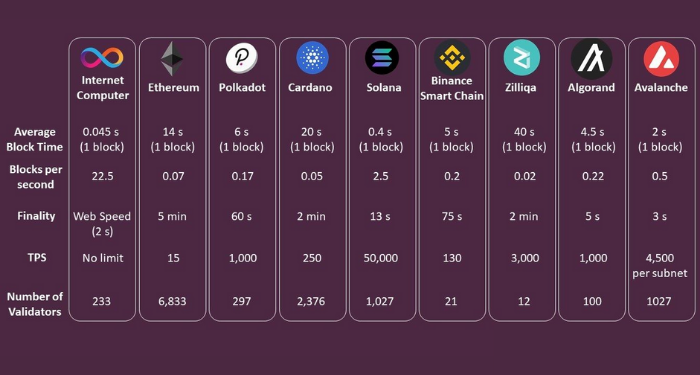Layer 1 and Layer 2 scaling solutions are important in the context of blockchain technology for several reasons:
Layer 1 and Layer 2 scaling solutions are crucial for overcoming the inherent limitations of blockchain technology, enabling it to scale for broader adoption, improve user experience, and support a wider range of applications.
How do Layer 1 and Layer 2 Scaling Solutions Work?

Layer 1 and Layer 2 scaling solutions are approaches to address scalability issues in blockchain networks. Let’s delve into each and understand how they work:
Layer 1 Scaling:
Definition: Layer 1 scaling solutions involve making changes to the underlying blockchain protocol itself. These changes aim to increase the network’s capacity to process and validate transactions directly at the base layer.
How it works:
- Block Size and Time: One way to scale at Layer 1 is by adjusting the block size or block time. Increasing block size allows more transactions to be included in each block, and reducing block time means new blocks are added more frequently.
- Consensus Mechanisms: Some Layer 1 scaling solutions involve changing the consensus mechanism. For instance, moving from proof-of-work (PoW) to proof-of-stake (PoS) can increase transaction throughput.
- Sharding: Sharding involves breaking the blockchain into smaller pieces called shards, each capable of processing its transactions. This parallel processing significantly improves the scalability of the network.
- Optimizations: Optimizations to the cryptographic algorithms or data structures used in the blockchain can also enhance its performance.
Examples:
- Bitcoin’s Lightning Network (though often considered Layer 2, it also has Layer 1 aspects).
- Ethereum 2.0 (when fully implemented, it will include a transition to PoS and the introduction of shard chains).
Layer 2 Scaling:
Definition: Layer 2 scaling solutions work on top of the existing blockchain and aim to increase scalability by handling transactions off-chain or in a way that doesn’t require the main chain’s direct involvement for every transaction.
How it works:
- Off-chain Transactions: Layer 2 solutions enable users to conduct transactions off-chain. Multiple transactions can occur between parties without every detail being recorded on the main blockchain.
- State Channels: These are private channels between users that allow them to transact among themselves without involving the main blockchain. The final state is then recorded on the main chain.
- Sidechains: Sidechains are separate blockchains pegged to the main blockchain. Transactions can occur on the sidechain with the final outcome recorded on the main chain.
- Plasma: Plasma is a framework that allows the creation of child chains attached to the main blockchain, each capable of processing its transactions.
Examples:
- Lightning Network: Implemented on top of Bitcoin, it allows fast and low-cost transactions through off-chain channels.
- Rollups: These are Layer 2 solutions that bundle and submit batches of transactions to the main chain, reducing the load on the main chain.
Layer 1 scaling solutions focus on modifying the underlying blockchain protocol, while Layer 2 solutions aim to improve scalability by handling transactions off-chain or in a more efficient manner on top of the existing blockchain. Often, a combination of both Layer 1 and Layer 2 solutions is employed to achieve optimal scalability.
Risks of Layer 1 and Layer 2 Blockchain Scaling Solutions
Both Layer 1 and Layer 2 blockchain scaling solutions come with their own set of risks. Let’s explore the potential risks associated with each:
Risks of Layer 1 Scaling Solutions:
Consensus Changes:
- Risk: Altering the consensus mechanism, such as transitioning from proof-of-work to proof-of-stake, may introduce security vulnerabilities or uncertainties.
- Impact: It could lead to unforeseen issues in network security and stability.
Network Forks:
- Risk: Implementing changes at the base layer may result in network forks, causing a split in the community and ecosystem.
- Impact: Forks can create confusion, dilute network effects, and potentially undermine the overall security and credibility of the blockchain.
Complexity and Bugs:
- Risk: Complex changes to the core protocol may introduce new bugs or vulnerabilities.
- Impact: Security breaches or network disruptions can occur, affecting user confidence and hindering adoption.
Decentralization Concerns:
- Risk: Some Layer 1 scaling solutions, like sharding, may raise concerns about decentralization.
- Impact: If not implemented carefully, it could compromise the decentralization principles of blockchain networks.
Risks of Layer 2 Scaling Solutions:
Centralization in Validators:
- Risk: Certain Layer 2 solutions may involve relying on a set of validators, potentially leading to centralization.
- Impact: Centralization can undermine the trustless nature of blockchain networks and introduce points of failure.
Security Risks in Off-chain Transactions:
- Risk: Layer 2 solutions often involve off-chain transactions, which may be susceptible to security risks.
- Impact: Unauthorized access, fraud, or disputes can arise, impacting the overall integrity of the system.
Liquidity Issues:
- Risk: Some Layer 2 solutions, such as state channels, may face liquidity challenges.
- Impact: Users might encounter difficulties in closing channels or accessing their funds in case of network congestion or other issues.
Smart Contract Compatibility:
- Risk: Certain Layer 2 solutions may have limitations in supporting complex smart contracts.
- Impact: Developers might face challenges in deploying certain applications or functionalities on Layer 2, restricting the ecosystem’s capabilities.
Reliance on Main Chain Security:
- Risk: Layer 2 Scaling solutions often rely on the security of the main chain.
- Impact: If the main chain is compromised, it could have cascading effects on Layer 2 solutions.
In both cases, careful planning, extensive testing, and community engagement are crucial to mitigating these risks. Blockchain projects need to strike a balance between scalability and maintaining the core principles of security, decentralization, and trustlessness.
DISCLAIMER: The information on this website is provided as general market commentary and does not constitute investment advice. We encourage you to do your own research before investing.

















